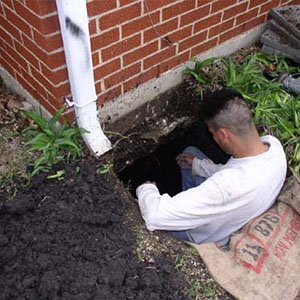Discovering Different Techniques of Foundation Repair Service for Different Dirt Types
Structure fixing is a crucial facet of keeping structural integrity, especially when thinking about the varied obstacles positioned by different soil types. The intricacy of dirt habits under differing conditions demands a customized technique to repair, making sure optimum remedies such as helical piers for unstable soils or chemical grouts for cohesive layers.
Recognizing Soil Kinds
Soil types play a vital function in the stability and longevity of structure foundations, making it vital for house owners and building specialists to understand their features and habits. The communication between soil and foundation can identify the architectural stability of a building. There are several dirt kinds, each with distinctive physical buildings that influence how structures are designed and maintained.
Granular soils, such as sand and gravel, supply great water drainage and are usually considered secure. They have high load-bearing capabilities, which can support much heavier structures. Nonetheless, these soils can change if not compacted effectively, causing potential negotiation issues. In contrast, cohesive dirts like clays and silts display different behaviors. These dirts tend to retain dampness, and their load-bearing capability can vary significantly with modifications in wetness content.
Rocky soils, known for their toughness and security, deal excellent support for foundations however might need customized equipment for excavation. On the other hand, fertile soils, which are a well balanced mix of silt, clay, and sand, often offer positive problems for foundation support as a result of their moderate water drainage residential or commercial properties.

Understanding these soil types is vital for picking appropriate foundation repair methods, guaranteeing the toughness and safety and security of structures over time.
Challenges With Expansive Clay
Among the various dirt kinds, large clay offers one-of-a-kind obstacles for structure security because of its propensity to undergo significant volume adjustments with dampness variant. This sort of soil swells when damp and contracts when dry, which can put in substantial pressure on structures. These fluctuations can result in structure fracturing, heaving, and negotiation problems, positioning substantial threats to the architectural stability of buildings.
The obstacles with extensive clay are worsened by its plasticity index, which measures the soil's capability to alter form and quantity. A high plasticity index shows greater potential for activity, raising the likelihood of damages to structures. This is specifically troublesome in regions experiencing extreme or regular weather adjustments, where cycles of damp and dry problems are usual.
Moreover, the depth of extensive clay layers can vary, complicating the evaluation and preparation of appropriate foundation fixing methods. These complexities need a thorough geotechnical examination to make certain effective foundation repair service approaches are implemented, highlighting the value of resolving expansive clay challenges with know-how and treatment.
Solutions for Sandy Soils
Sandy soils, characterized by their large particle dimension and reduced communication, existing unique challenges for foundation stability due to their tendency for changing and disintegration. By anchoring the foundation to much deeper, extra secure dirt layers, these systems can offer the required support to neutralize the changing nature of sandy dirts.
One more recommended technique is the application of dirt stabilization methods. Chemical navigate to this website grouting, for example, includes infusing a maintaining agent into the dirt, which boosts communication and minimizes permeability. This process helps to strengthen the sandy substrate, thus decreasing the risk of disintegration and motion.
Additionally, setting up appropriate drainage systems is crucial in sandy dirt problems. Making certain ample drain can protect against water build-up around the structure, which commonly exacerbates erosion and dirt displacement. Methods such as French drains or surface grading can be used to guide water away from the structure perimeter.
Dealing With Clearing Up in Loamy Soils
Loamy soils, understood for their well balanced mix of sand, clay, and silt, offer an abundant base for several frameworks but can occasionally bring about foundation settling as a result of their unique make-up. This balanced appearance supplies outstanding drain and nutrient retention, making it excellent for farming and landscape design. This exact same feature can become troublesome for structures, as changes in moisture material can create the dirt to expand or agreement, leading to settling.
Attending to resolving in fertile soils requires a diverse technique. Precise soil testing is vital to establish the details composition and moisture content of the loam. Once data is collected, applying proper water drainage options is crucial to maintain constant moisture levels, thus reducing the risk of dirt tightening or growth. French drains or surface grading are effective methods to reroute water far from the foundation.

Ingenious Fixing Methods
In the realm of structure repair work, innovative methods are continually being established to address the complex tests posed by various dirt conditions. As soil kinds differ dramatically in their structural buildings, conventional methods may not always are sufficient. The advent of new modern technologies in this content foundation repair service gives a lot more tailored options, ensuring stability and durability.
One notable development is making use of helical piers, which are particularly effective in unsteady or large dirts (foundation repair okc ok). These piers are screwed right into the ground till they get to a stable layer of dirt, offering strong assistance for the structure over. This approach minimizes disruption and is adaptable to different soil types, making it a flexible remedy
An additional cutting-edge technique is the application of polyurethane foam injection. This method entails injecting high-density polyurethane foam under the structure to fill voids and stabilize the structure. It is a less invasive option to conventional underpinning, supplying quick setup with very little disturbance to the surrounding area.
Additionally, soil stabilization approaches, such as the usage of chemical grouts, have acquired traction. These compounds improve soil toughness and decrease leaks in the structure, preventing future shifting. Jointly, these ingenious fixing strategies give reliable remedies for the varied difficulties presented by varying soil conditions.
Conclusion

Foundation fixing is a vital aspect of preserving structural honesty, especially when taking into consideration the diverse difficulties posed by various dirt types (foundation repair okc). The complexity of soil habits under differing conditions requires a customized method to website link fix, ensuring ideal options such as helical piers for unstable soils or chemical cements for cohesive layers. By anchoring the foundation to much deeper, more steady dirt layers, these systems can give the needed assistance to counteract the moving nature of sandy dirts
Structure repair needs cautious factor to consider of dirt types to make sure security and longevity. Chemical grouts enhance soil stamina and lower permeability in cohesive soils.
 Ralph Macchio Then & Now!
Ralph Macchio Then & Now! Andrew Keegan Then & Now!
Andrew Keegan Then & Now! James Van Der Beek Then & Now!
James Van Der Beek Then & Now! Karyn Parsons Then & Now!
Karyn Parsons Then & Now! Rossy de Palma Then & Now!
Rossy de Palma Then & Now!